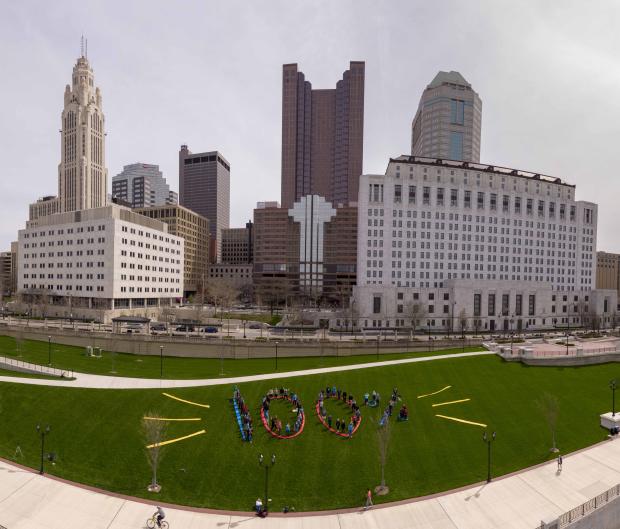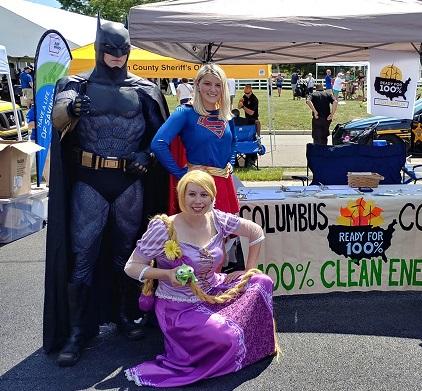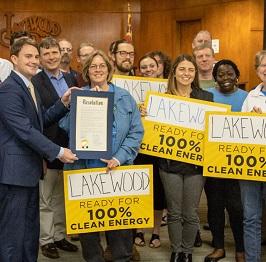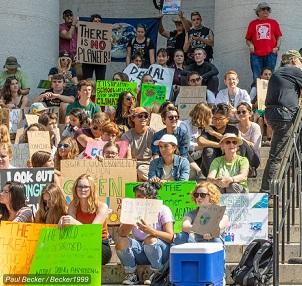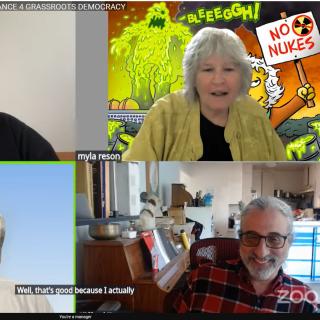On February 13, Columbus Mayor Andrew Ginther made a stunning announcement in his annual State of the City address: Columbus would transition its electricity supply to 100% renewable energy by 2022 through a program called Community Choice Aggregation.
“Not only will this help our climate goals and commitments, but it will drive workforce development and job creation in the clean-energy sector for our city and region,” Ginther said.
It was the exact case that Ready for 100 Columbus, a group of local climate activists, has been making to city government for the past three years.
Ready for 100 is a campaign of the Sierra Club asking cities to commit to 100% renewable energy. So far 162 cities, 13 counties, eight states, Puerto Rico, and the District of Columbia have all made this commitment. In Ohio that includes Cleveland, Cincinnati, Lakewood – but so far not Columbus.
Ready for 100 targets cities not just because we have a fossil fuel-loving federal government – and the same in Ohio -- but also because cities are responsible for more than 70% of the carbon emissions at the root of the climate crisis.
Even if we had the most climate-friendly federal and state governments in the world, we would still be working with cities. Columbus is the 14th largest city in the country, so how we address the climate crisis on the local level matters.
Since 2017, our intrepid team of Ready for 100 volunteers has:
- Organized an aerial art project with 100 people spelling out a giant ”100%” on Scioto Mile.
- Held a 100% Clean Energy for All Training with energy leaders from Cleveland, Cincinnati, and Oberlin.
- Helped organize a Rise for Climate, Jobs, and Justice rally that drew 100 participants despite pouring rain.
- Screened “Reinventing Power” and with panel discussion by local energy experts.
- Held community dialogues in Franklinton and Linden.
- Participated in three Green New Deal town halls.
- Tabled at dozens of community festivals and events to gather 5,000 signatures on our petition to the city.
- Spoken to 500 people at Josh Fox’s performance of “The Truth Has Changed.”
- Spoken to 800 attendees at the September 2019 youth climate strike.
- Brought Bill McKibben to speak to 100 people about the 2020 Democratic primary.
- Maintained a Facebook presence that reaches 2,000 people per month.
So how could Columbus get to 100% renewable energy? Here are a few steps.
Energy efficiency. Buildings are the top source of carbon pollution in Columbus, responsible for 58% of the city’s emissions. The city has started to address this by performing 30,000 home energy audits targeting low-income areas and passing a benchmarking ordinance requiring owners of large buildings to disclose their energy use.
But there’s more we should do. We could provide assistance to low-income residents to make energy efficiency upgrades to their homes, saving money on energy bills they could spend on other necessities. We could give tax breaks only to property owners who retrofit large buildings and developers who design new buildings to high-efficiency standards.
The city must also address the split incentive in which tenants are responsible for energy bills while landlords are responsible for retrofit costs. Landlords should be required to disclose average energy costs along with rent, so tenants know if a property is energy inefficient, and landlords could be provided with various carrots and sticks to get them to make upgrades.
Renewable energy. To transition to 100% renewable energy, we need more renewable energy. The city already has solar panels on some properties such as its Fleet Management Facility. All city buildings that can host solar panels, including schools, libraries, and recreation centers, should have them.
Even more important is helping homeowners, business, and landlords install renewable energy across the community through actions such as streamlining regulations and waiving fees.
We also need programs such as the Columbus Area Solar and EV Charger Co-op, sponsored by Solar United Neighbors. The co-op, which closes April 30, allows members to install solar panels at discounted bulk price rates.
Transportation is responsible for 38% of carbon emissions in Columbus, the second-highest source. Fortunately, cities have a lot of options for tackling transportation emissions.
Columbus is working to transition its city fleet to greener alternatives; however, some alternatives are greener than others. Electric vehicles are the top choice followed by plug-in hybrids. Vehicles powered by compressed natural gas are not green unless the energy comes from landfill gas, not fracking. Diesel and propane are even worse.
Encouraging community members to consider electric vehicles is also crucial. That requires rolling out charging stations across the city and providing driver education such as the Smart Columbus test drive events. Once people decide to go electric, they don’t go back.
We must also do better at alternative transportation. Central Ohio is expecting 1 million more people by 2050, but our streets and interstates do not have room for 1 million more cars.
We must strengthen bus rapid transit to make riding the bus more “rail like” with raised platforms, pre-bought tickets, and faster routes. We must make bicycling and walking safer by building complete streets with designated bike lanes and sidewalks throughout the city. And we should take another look at light rail. Columbus is the largest city with no rail system of any sort.
Finally, we must practice smart growth, funneling development into the city core instead of urban sprawl, while requiring truly affordable housing to discourage gentrification. We need to preserve our green space, build out our urban forest, and protect our rivers and streams. Balancing all these demands is a tall order, but it’s part of investing in ourselves and our future.
Energy supply. We are lucky in Ohio to have Community Choice Aggregation, a program legal in only eight states. CCA is “collective bargaining for energy,” allowing cities to pool all their customers to leverage 100% renewable energy from the utilities at a competitive price.
For cities to pursue Community Choice Aggregation, citizens must agree to let the city negotiate with utilities on their behalf. This is done through a ballot initiative, which Ginther has said will be on the Columbus ballot in November. The initiative must allow those who do not want to participate to opt out; however, most people stay in.
Cincinnati aggregated for 100% renewable energy back in 2012, the basis of its Ready for 100 commitment. Last year, three-fourths of voters in Worthington passed aggregation for 100% renewable energy.
If aggregation passes in Columbus, the next question is, where does the renewable energy come from? For years Cincinnati bought Renewable Energy Certificates, or RECs. For every unit of energy consumed in the city from fossil fuels, the city would purchase renewable energy units generated elsewhere. This is better than nothing because it stimulates the renewable energy market in general, but it does not bring renewable energy directly into the city.
Better is to use the collective bargaining power of city residents to build out local sources of renewable energy. Recently Cincinnati did just that when it contracted to buy 100 MW of energy from a solar farm in Highland County. In fact, the city’s agreement to buy this energy is what spurred the bank to finance construction of the project, sustainability director Larry Falkin said.
Financing. The first question on any renewable energy project is usually, “How will you pay for it?” Fortunately, cities have lots of financing mechanisms to choose from.
In Columbus, owners of large buildings are using PACE, or Property Assessed Clean Energy, to finance energy efficiency upgrades through their property taxes. PACE allowed the owner of PNC Plaza to finance $3.3 million in efficiency upgrades to its 24-story office tower. Columbus is currently working on a plan to extend the PACE program to residential homeowners.
Other cities have their own financing programs. For example:
- Los Angeles allows low-income residents to “rent” their rooftops to the city electric utility, which installs solar panels that put clean energy on the grid.
- Atlanta offers a “round it up” program for customers to pay a little extra on their utility bills; the money funds energy efficiency upgrades in low-income areas.
- New York has a Green Bank that works with private-sector banks to fund clean energy developments.
The city of Columbus has come a long way since Ready for 100 launched its campaign here three years ago. While we can’t claim full credit for the city’s climate progress, we played a significant role in, for example, helping Columbus land the American Climate Challenge Grant. The city also deserves credit for taking on this challenge and laying the foundation for a transition to 100% renewable energy.
Now we need to take the final steps by passing community choice aggregation for 100% renewable energy and using it to leverage buildout of a local renewable energy supply.
Meanwhile Ready for 100 has expanded to other cities across Ohio, with active teams now meeting in Akron, Dayton, Marietta, Toledo, and Worthington, among others. Other cities are seriously considering aggregation for 100% renewable energy, and Mayor Ben Kessler of Bexley has taken the Mayors for 100% Clean Energy Pledge.
Unfortunately, Ohio state government remains intransigent regarding the urgency of the climate crisis and the need for renewable energy. Although Gov. Mike DeWine has shown great leadership and respect for medical science during the coronavirus pandemic, he also signed House Bill 6, which guts our renewable energy standards and forces every Ohio resident to pay to bail out FirstEnergy’s old nuclear and coal plants, one of which isn’t even in Ohio.
Ready for 100 will continue its activism in Ohio, bringing more cities into the 100% renewable energy fold, and urging them to push for development of local renewable energy projects.
Hopefully at some point this will move state government to act on climate science as they have acted on medical science. The result would be cleaner air, cleaner water, more jobs, better health, and a higher quality of life for every Ohioan.
Cathy Cowan Becker is chair of the Ready for 100 campaign in Columbus and statewide. She recently earned a dual masters in public administration and environment and natural resources from Ohio State University.
Pictured:
Top: Mother Nature showed up at Rise for Climate, Jobs, and Justice in September 2018. Photo by Paul Becker.
Side show below:
Gathering signatures on our petition to the city at Gallery Hop in April 2019.
Ready for 100 aerial art on Scioto Mile on Earth Day 2018.
The Ready for 100 table got a visit from superheroes at Grove City Ecofest in August 2019.
About 20 people attended a training on how to host a community energy dialogue in August 2019.
Lakewood, Ohio, committed to 100% renewable energy in October 2019. Photo by Paul Becker.
Climate Strike at the Ohio Statehouse in September 2019. Photo by Paul Becker.
Ready for 100 had a busy table at Comfest in June 2019. Table banner by Laurel Hobden.
The Ready for 100 table included a community painting project at Green on the Green in May 2019. Photo by Alana Simmons.


